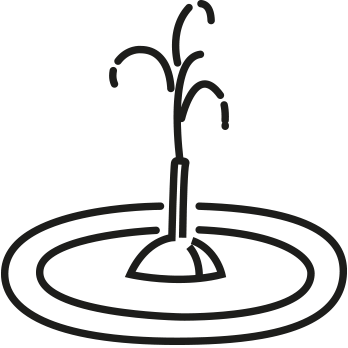As Rufus Humphrey prepares for the opening of the latest exhibition at his eponymous gallery, for which no one has RSVP’d, Lily van der Woodsen-Bass – née Rhodes, and formerly Humphrey and Bass – is arranging the final details for her Sotheby’s auction, to benefit the Art Production Fund. Scandal ensues.
Gossip Girl was broadcast from 2007 ’til 2012, and produced by Stephanie Savage and Josh Schwartz – of The OC – for the television network, The CW. The ruling passion is power. It’s dry with a dash of satire – knowing and sarcastic, without losing the magic of the unreal. Gossip Girl embraced the truth of our never really leaving high school, and festooned it with the perks of adulthood.
The teen drama focused on exactly that: the trials and tribulations of insufferable, privileged teenagers as they navigate addiction, affairs, murder and property empires, and dip in and out of being related to each other. Rampantly jealous and wildly loyal, the central characters – Serena van der Woodsen, Blair Waldorf, Nate Archibald, Chuck Bass, and Dan Humphrey – oscillate around each other, twisting and turning between love and hate. The story goes that an anonymous blogger, Gossip Girl, is tracking the every move of the senior class at a prep school on New York’s Upper East Side; and the show opens with the mysterious return of former ‘Queen Bee’ Serena, who disappeared to a Connecticut boarding school after sleeping with the boyfriend of Blair (her BFF), among other dramas.
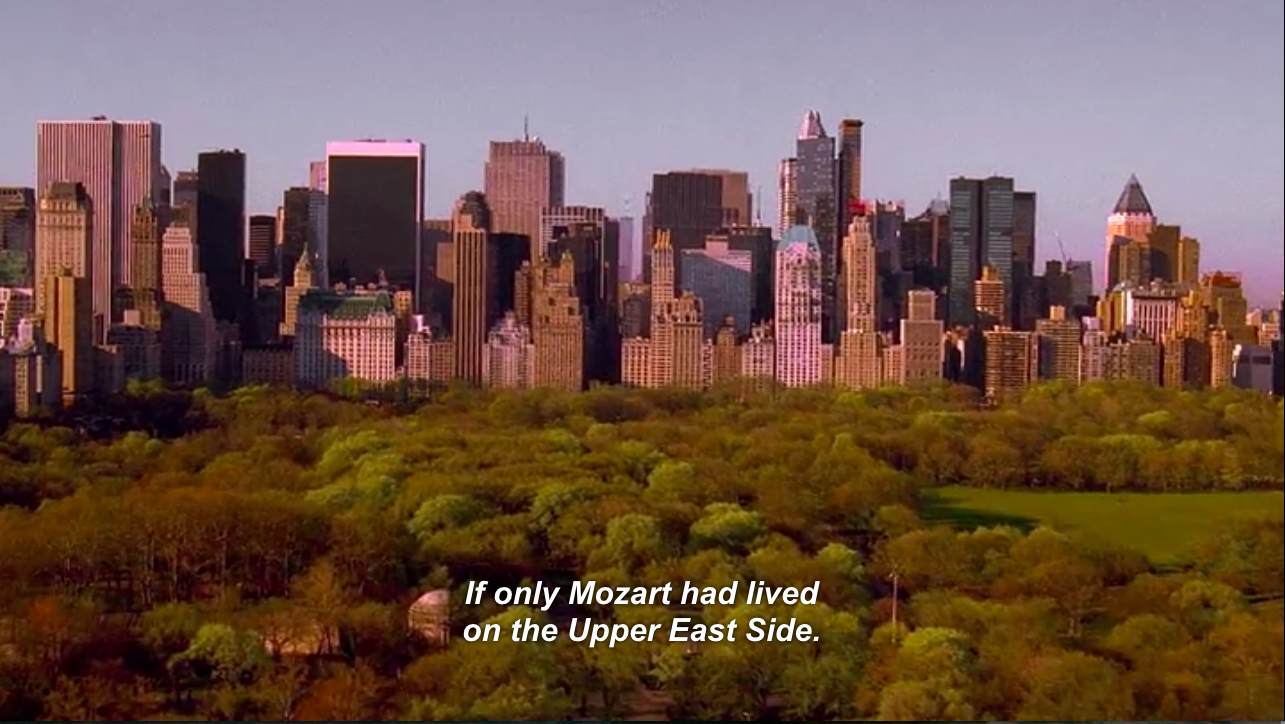
Gossip Girl may be one of the first programmes to engage so enthusiastically with the inanimate as character. The disembodied voice of Gossip Girl – who turns out to be a man – is a woman, who plays what may be considered the central role, and is not ‘seen’ or ‘known’ until the final episode. She/he/it lives in the mobile phones and on the screens of the characters, and directs their lives. Arguably, the animated inanimate precedes the animate.
Through each season the characters speed through relationships, surnames, jobs, colleges, and principalities, and although the teen amateur oligarchs are certainly busy, the central characters populating Gossip Girl’s New York aren’t always the teen idols. First, there’s the aforementioned disembodied narrative voice of Gossip Girl and second the artwork – closely followed by the borderline hysterical product placement.
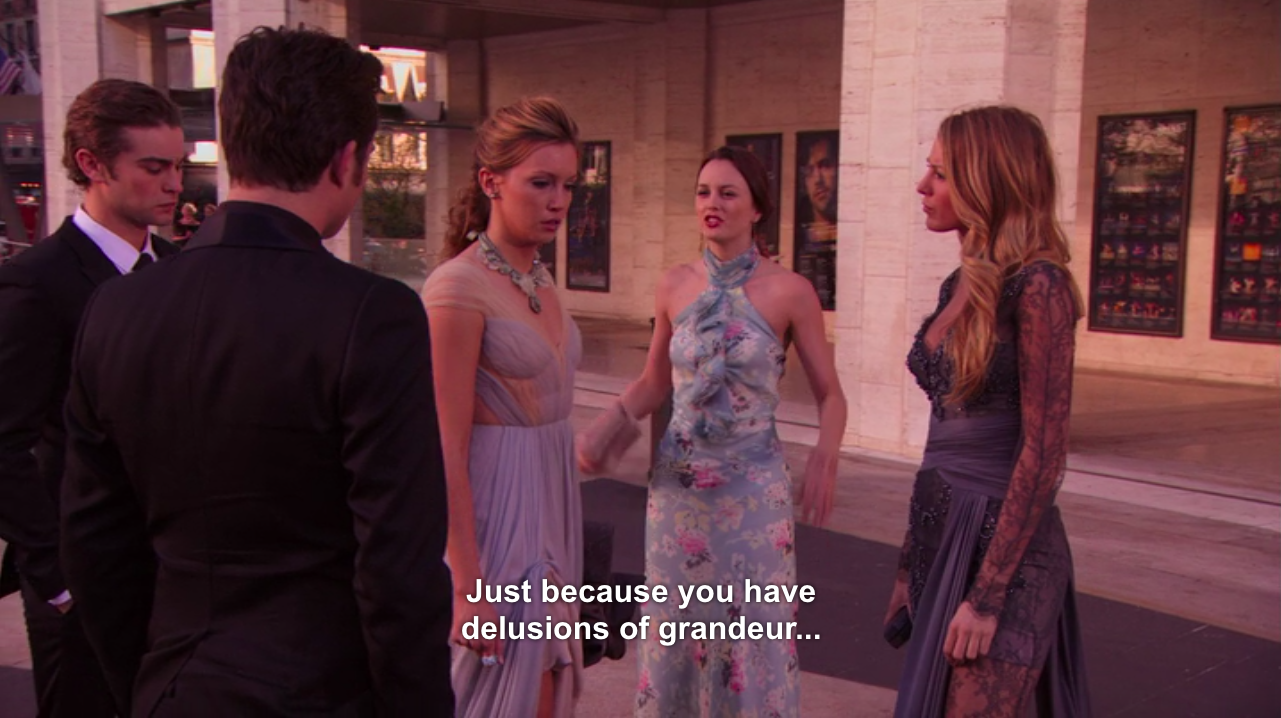
In 2007, the executive producers behind Gossip Girl worked with the Art Production Fund – a non-profit organisation which produces public art projects – on one of the first instances of a collaboration between a TV series and contemporary artists. In consultation with the Gossip Girl team, APF chose works by artists such as Kiki Smith, Marilyn Minter, Ryan McGinley and Richard Phillips, which were hung in the penthouse apartments and hotel suites populated by the key screen families.
The main location was Lily van der Woodsen’s apartment, and her ‘collection’ was unveiled in the fifth episode of Season 2. She enters the apartment already in conversation with her art consultant, Bex, who, on exiting the lift, introduces Lily to her newly adorned surroundings:
Bex: Kiki Smith greeting you in the foyer, Elm & Drag pulling you into the main room…
Lily: Oh, I love that…
Bex: And making a statement on the stairwell, Richard Phillips.
Lily: … isn’t it just breathtaking?
Bex: Any museum would be thrilled.
Richard Phillips’ Spectrum is the star piece. Hung at the centre of the space, above the glass stairwell, it features not only in conversation but also as a central character. Known by the core gang as ‘the rainbow woman’, in the final season the painting is embroiled in an elaborate scheme.
It’s the sixth episode of Season 6, otherwise known as ‘Where the Vile Things Are’, and Spectrum is at centre stage. Nate, the local all-American, dead-behind-the-eyes good guy, has a rare brainwave and steals the phone of the financial advisor to Bart Bass (the formerly dead, hotelier father of Chuck, Nate’s best friend), in the hope of unearthing the secret of where Bart has hidden a suspicious envelope – the records of an illegal oil deal with a Sudanese sheikh. (Really.)
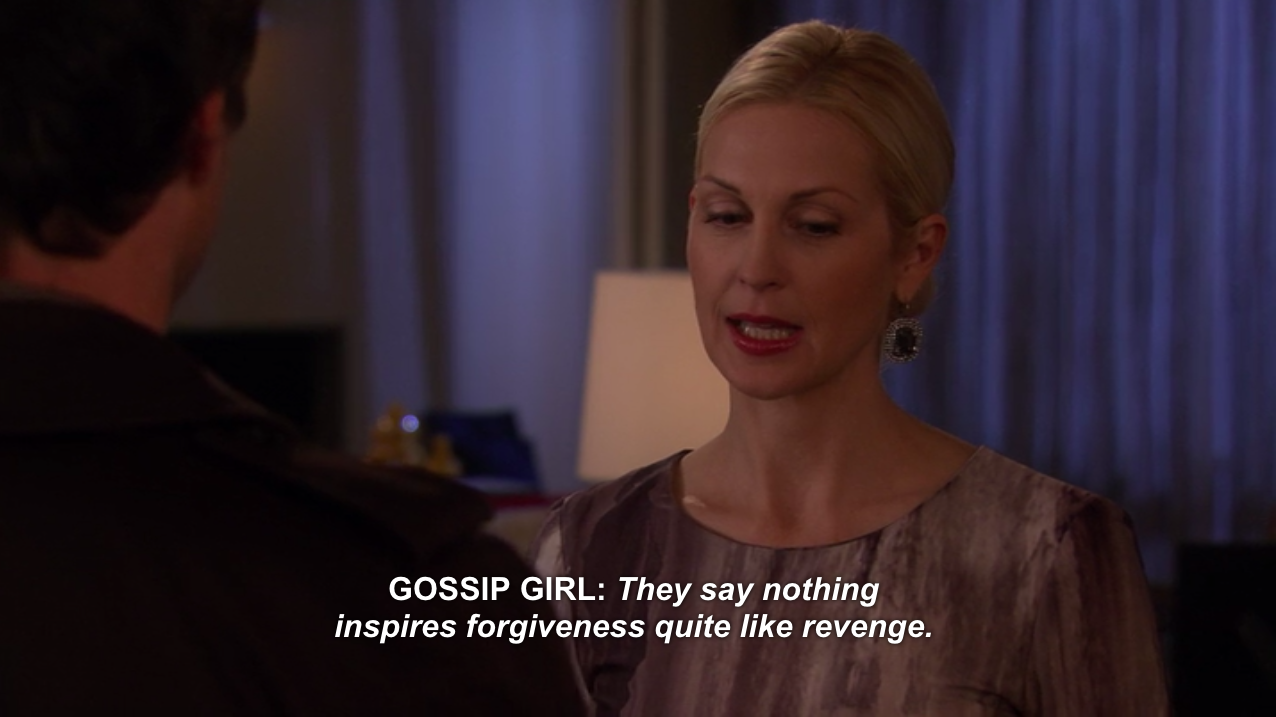
Nate and Chuck trawl the phone for clues and find one in its calendar: ‘Bass, Traffic’. It turns out that the advisor records each of his money-saving plots with the name of a film, and in this case it’s Traffic, a film in which, as Chuck kindly explains, ‘the head of the drug cartel stored his illegal account information in the back of a painting’. But Chuck has been banned from his sort-of familial home – his mother may or may not have died soon after giving birth to him, and his father had been long dead before he unceremoniously reappeared in the back room of a brothel in upstate New York, only to commandeer his real estate empire from Chuck who, at 19 and in the midst of grief, had continued his father’s legacy – so Nate takes on the responsibility of “paying them a visit”.
On entering the apartment, Nate realises that “The rainbow woman is gone!” It is in fact at Lily van der Woodsen’s Sotheby’s art auction for the APF, where Rufus Humphrey is wreaking havoc with his current spouse, and former step-daughter (scandal), Ivy Dickens. Ivy inherited half of Lily van der Woodsen’s mother’s estate, having been employed by Lily’s sister to impersonate her daughter, with the aim of commandeering her trust fund. She is now masquerading as Rufus’s girlfriend, but is actually in cahoots with Lily’s ex-husband, William van der Woodsen, to destroy Lily – or so she thinks…
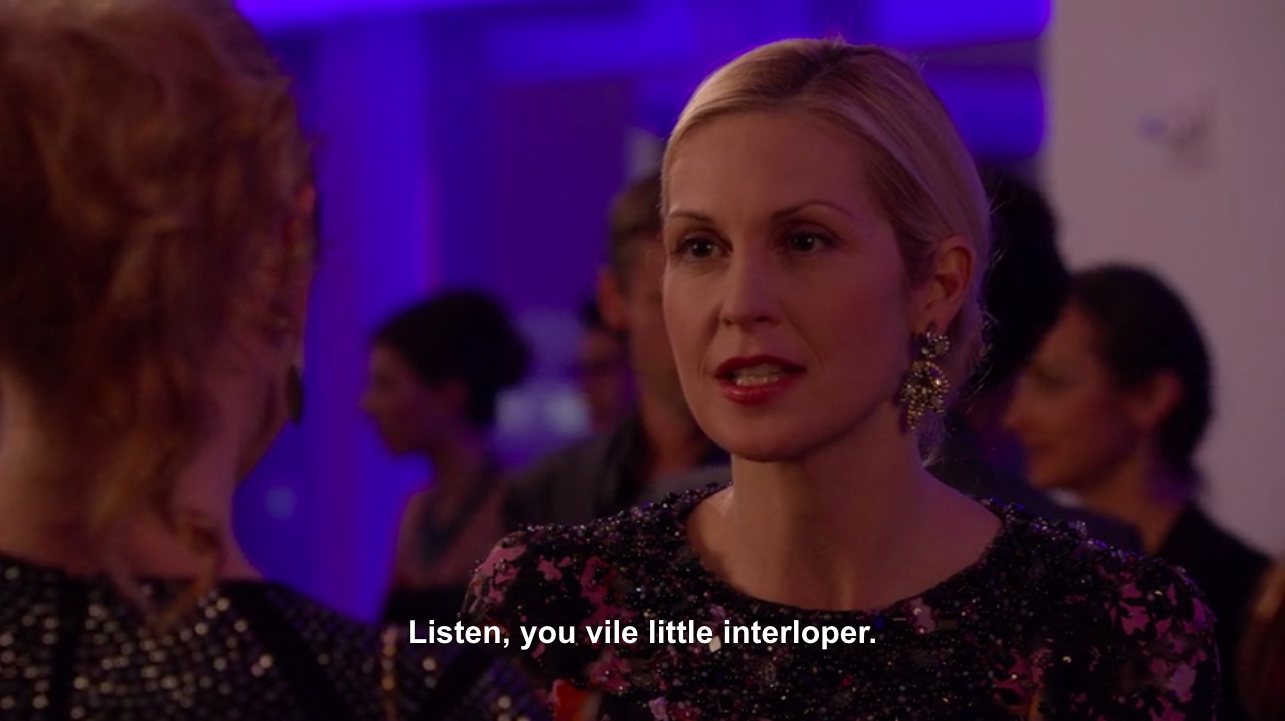
Back at the auction, in an effort to resolve the gallery panic, Ivy has bought every painting, and made a deal with Sotheby’s to display the work from Rufus’s gallery. Lily panics at the thought of sharing the spotlight with both Ivy and her ex-husband, and so enters Spectrum for auction. The painting – behind which Bart Bass has hidden the aforementioned microfilm – stars in a live auction, a battle between Lily, Ivy, and Chuck, which ends at a crescendo of one million dollars. From here, it’s just a hop, skip and a jump through promises of ruin and sex games before the evidence goes up in flames. It’s really very straightforward.
Snobbery is looked down upon.
The distinction, or lack thereof, between the animate and inanimate in Gossip Girl, is the only aspect of the series in which the hierarchy is flat, if not non-existent. The characters’ clothes speak with more clarity and purpose than the characters can seem to portray; they trade each other as often as they sell stories or hotels (and occasionally for hotels), and the art that surrounds them has a life of its own – in and out of the show.
After the collaboration between Gossip Girl and the APF came to fruition, a series of prints went into production, selling at 250 dollars apiece, and APF co-founder Doreen Remen – who also guest-starred in ‘Where the Vile Things Are’ – waxed lyrical about the impact of displaying work on screen: “Exhibiting artworks in this context is a way to engage people in their daily lives; a chance to generate a spark of interest that may grow into something thought-provoking and mind-opening”. In the episode, Remen reflected this statement, and Richard Phillips went along with Humphrey’s questionable interpretation of art history:
Doreen Remen: I like that your art is reflecting the same socially relevant projects we commission at the Art Production Fund.
Rufus Humphrey: And I like that you can see the street art influence. I’m not talking about the ’80s, but the ’40s. Dubuffet, Pollock, Ray Johnson.
Richard Phillips: When artists were the stars of New York, instead of celebutantes.
In this star turn, Gossip Girl did what it did best, layering references upon references. Phillips’ comment makes a joke of the show, and somewhat of himself. By having artworks ‘starring’ in a network show, and guest-starring in the show himself, he reaches the apex of Pop, and somehow brings Gossip Girl into its history. In an interview with The New York Times, Phillips said: “It’s so wonderful how my work has been able to reach out, Warhol would never have been able to dream of such a thing”.
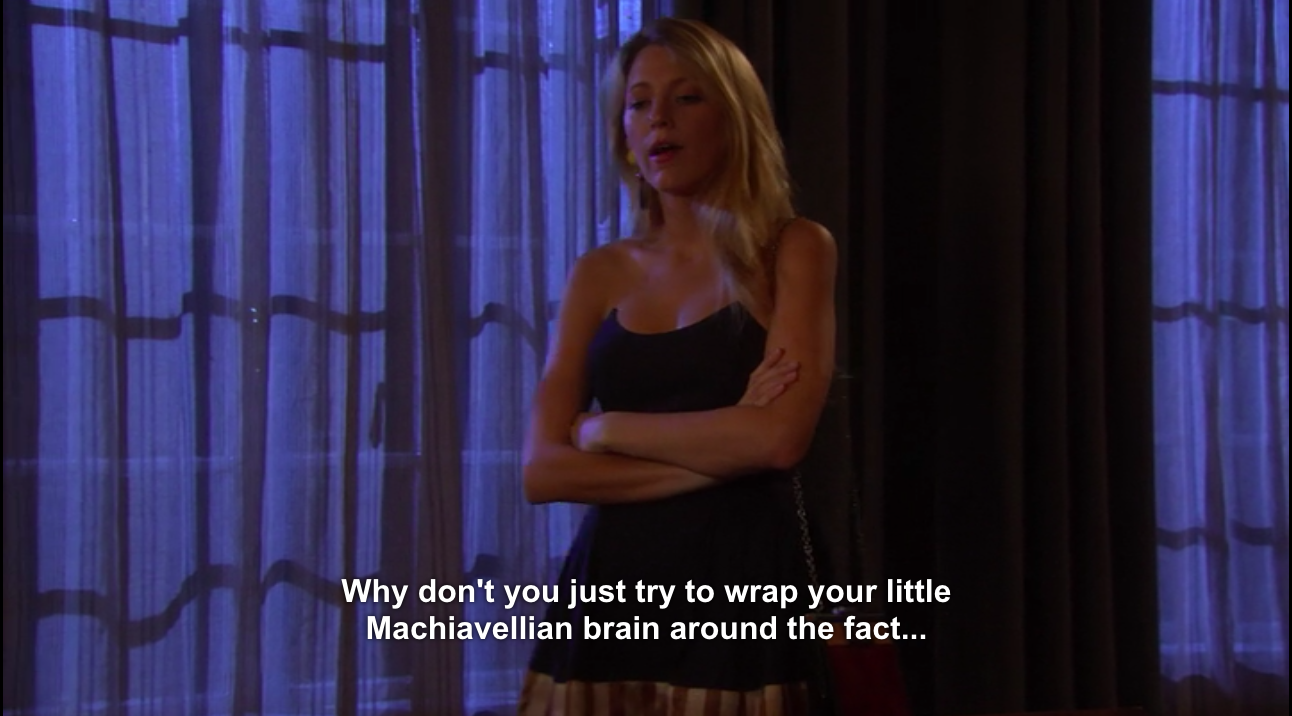
Not unlike Andy Warhol’s Factory, Gossip Girl attracted a wild mix of personalities while it mass-produced images – of artworks, of themselves, of New York – and moving images. The show regularly spliced the realms of fact and fiction, the plausible with the implausible, and was somehow just dry enough to convince established artists and organisations to go along with its high jinks. Politicians, ballet dancers, designers, and musicians both star and are referenced, and real-world scandals are accounted for. New York plays itself. Mayor Bloomberg plays himself. Sonic Youth play a special set for Rufus and Lily’s wedding.
The inner circle’s relationships crossed over in reality and on the show, and gossip about the actors was as popular as gossip about and between the characters. Real-life columnists reviewing Gossip Girl appeared as characters, and character arcs appeared in real-world expressions. Serena and Dan dated on the New York set while Blake Lively and Penn Badgley, who played the aforementioned characters, dated on the New York streets.
Every episode would reach a crescendo at a high-production gala, auction, or masked ball, with the characters walking the red carpet, being chased by paparazzi and featured on Page Six. Every week would close with a mirroring reality for Gossip Girl’s stars, often in the same elaborate outfits, on the same marble steps. In a conversation with New York magazine, Penn Badgley (Dan Humphrey) said: “Look, the show that we’re on, it wants us to be celebrities, it’s trying to launch us into the media like a project. You know. Like a social experiment”.
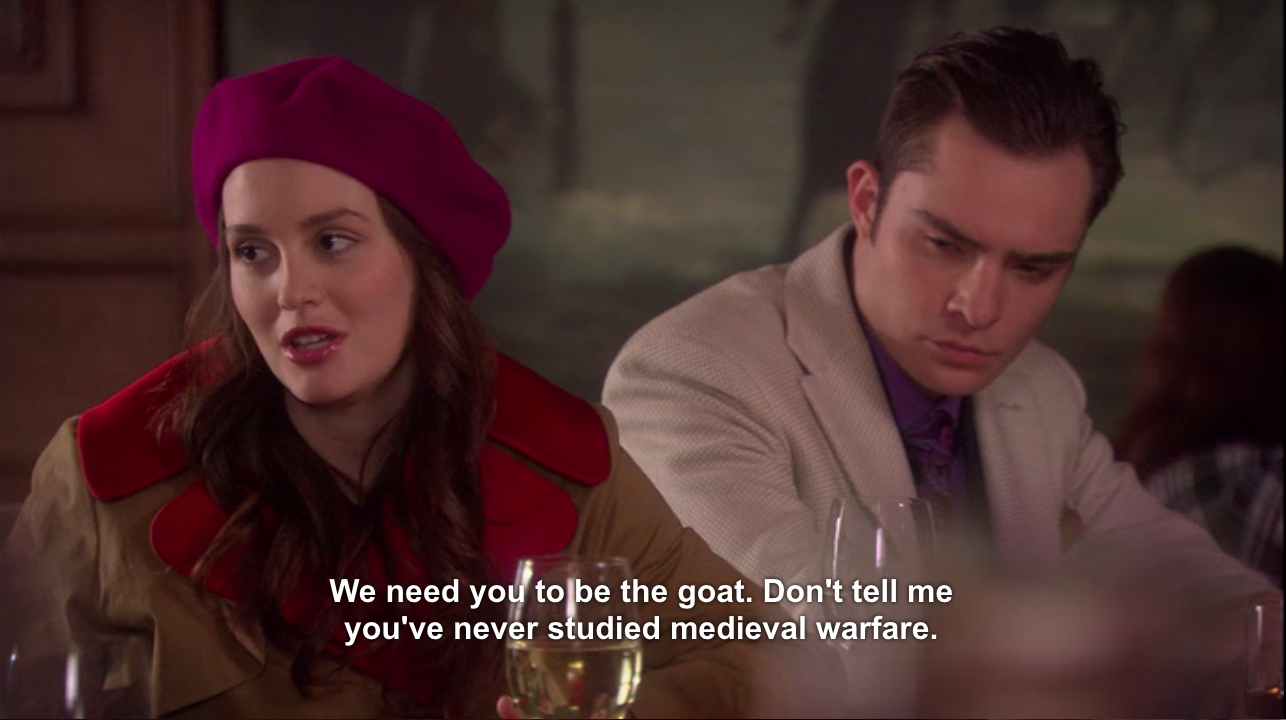
Gossip Girl was distributed internationally and spawned a number of spin-offs, but it was the way that it permeated and was scattered across New York that was most remarkable. In a bizarre, regurgitating food chain, Gossip Girl would be consumed by New York, and New York would be consumed by Gossip Girl. Like pigs in shit. The show went high and low, far and wide, extolling the virtues of VitaminWater, Windows phones, and Chanel make-up, with the regularity and fervour of an underfunded lifestyle magazine. In addition to featuring figures such as publisher Jonathan Cape, critic Charles Isherwood, novelist Jay McInerney, and journalist Hamish Bowles, the show also coupled up n+1’s former editor Keith Gessen with Elizabeth Hurley, when she was moonlighting as a newspaper editor at The New York Spectator, sleeping with Nate and pretending to be Chuck’s mother.
Elmgreen & Dragset’s Prada Marfa sign, which holds a prime spot in Lily van der Woodsen’s apartment, was made especially for the show – as a precursor to the permanent Prada Marfa sculpture in Texas, which was made in partnership with the Art Production Fund. The print, known on APF’s site as ‘Elmgreen & Dragset – Prada Marfa Sign (Prop Art)’ can be bought for as little as $149.99 on Art.com. It has also spawned countless imitations, including images of signs pointing to Paris, New York, and London, and a variety of ‘PRADA’ signs in a mix of typefaces, printed in gold, on marble and in millennial pink.
In 1977, Printed Matter was founded in Tribeca, New York, by Sol LeWitt and Lucy Lippard, with the intention of disseminating artists’ books. To quote from details of the organisation’s history on Printed Matter’s website:
Large-edition and economically produced publications allowed for experimentation with artworks that were democratically accessible, affordable, collaborative, and could circulate outside of the mainstream gallery system. Printed Matter provided a space that championed artists’ books as complex and meaningful artworks, helping bring broader visibility to a medium that was not widely embraced at the time.
Why shouldn’t the next logical step be dissemination in the background – and foreground – of teen drama?
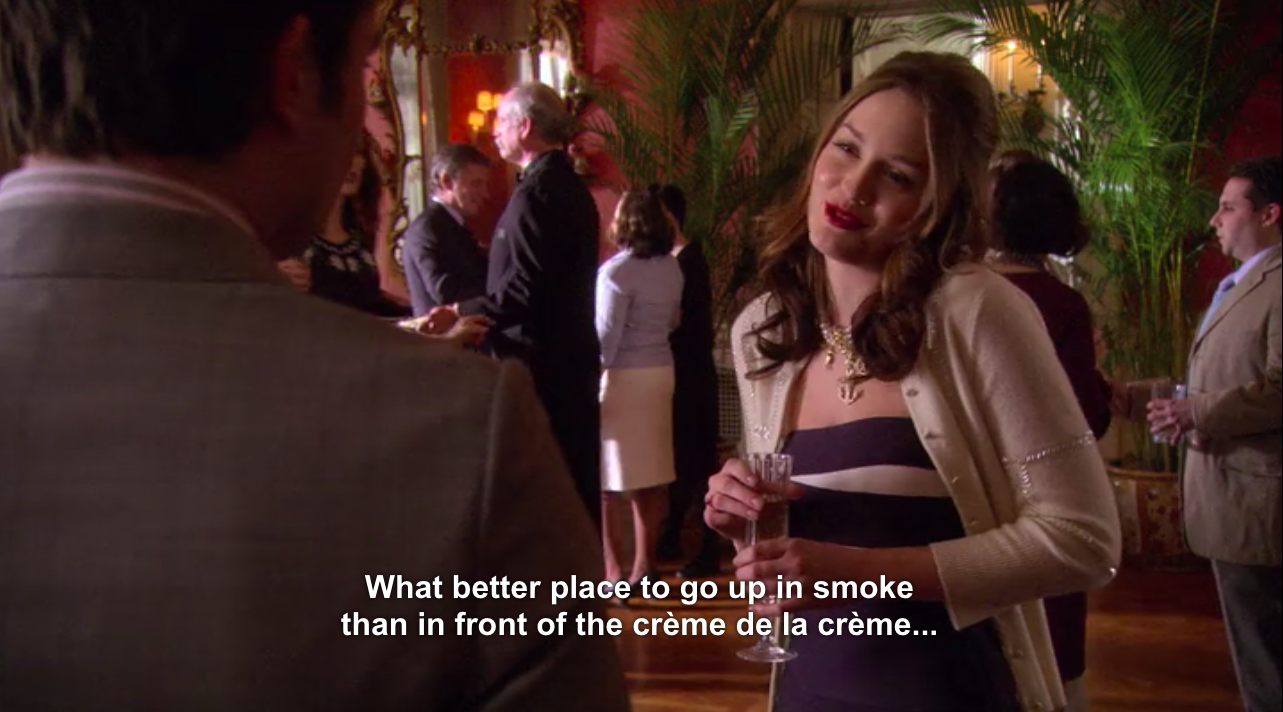
There were few – if any – redeeming features of the characters who made up Gossip Girl’s New York – and that was their best quality. If anyone had a virtue, it was in their total, uncompromising embrace of viciousness and vacuity. This doomed bourgeoisie, in ‘love’, addressed culture and politics with the same confident lack of care they inflicted upon each other. If an art of and for the people is what we want and need, here’s a playbook. To quote Jean Genet’s The Thief’s Journal: “To achieve harmony in bad taste is the height of elegance”.
XOXO, Gossip Girl
2018
Gossip Girl was broadcast from 2007 ’til 2012, and produced by Stephanie Savage and Josh Schwartz – of The OC – for the television network, The CW. The ruling passion is power. It’s dry with a dash of satire – knowing and sarcastic, without losing the magic of the unreal. Gossip Girl embraced the truth of our never really leaving high school, and festooned it with the perks of adulthood.
The teen drama focused on exactly that: the trials and tribulations of insufferable, privileged teenagers as they navigate addiction, affairs, murder and property empires, and dip in and out of being related to each other. Rampantly jealous and wildly loyal, the central characters – Serena van der Woodsen, Blair Waldorf, Nate Archibald, Chuck Bass, and Dan Humphrey – oscillate around each other, twisting and turning between love and hate. The story goes that an anonymous blogger, Gossip Girl, is tracking the every move of the senior class at a prep school on New York’s Upper East Side; and the show opens with the mysterious return of former ‘Queen Bee’ Serena, who disappeared to a Connecticut boarding school after sleeping with the boyfriend of Blair (her BFF), among other dramas.

Gossip Girl may be one of the first programmes to engage so enthusiastically with the inanimate as character. The disembodied voice of Gossip Girl – who turns out to be a man – is a woman, who plays what may be considered the central role, and is not ‘seen’ or ‘known’ until the final episode. She/he/it lives in the mobile phones and on the screens of the characters, and directs their lives. Arguably, the animated inanimate precedes the animate.
Through each season the characters speed through relationships, surnames, jobs, colleges, and principalities, and although the teen amateur oligarchs are certainly busy, the central characters populating Gossip Girl’s New York aren’t always the teen idols. First, there’s the aforementioned disembodied narrative voice of Gossip Girl and second the artwork – closely followed by the borderline hysterical product placement.

In 2007, the executive producers behind Gossip Girl worked with the Art Production Fund – a non-profit organisation which produces public art projects – on one of the first instances of a collaboration between a TV series and contemporary artists. In consultation with the Gossip Girl team, APF chose works by artists such as Kiki Smith, Marilyn Minter, Ryan McGinley and Richard Phillips, which were hung in the penthouse apartments and hotel suites populated by the key screen families.
The main location was Lily van der Woodsen’s apartment, and her ‘collection’ was unveiled in the fifth episode of Season 2. She enters the apartment already in conversation with her art consultant, Bex, who, on exiting the lift, introduces Lily to her newly adorned surroundings:
Bex: Kiki Smith greeting you in the foyer, Elm & Drag pulling you into the main room…
Lily: Oh, I love that…
Bex: And making a statement on the stairwell, Richard Phillips.
Lily: … isn’t it just breathtaking?
Bex: Any museum would be thrilled.
Richard Phillips’ Spectrum is the star piece. Hung at the centre of the space, above the glass stairwell, it features not only in conversation but also as a central character. Known by the core gang as ‘the rainbow woman’, in the final season the painting is embroiled in an elaborate scheme.
It’s the sixth episode of Season 6, otherwise known as ‘Where the Vile Things Are’, and Spectrum is at centre stage. Nate, the local all-American, dead-behind-the-eyes good guy, has a rare brainwave and steals the phone of the financial advisor to Bart Bass (the formerly dead, hotelier father of Chuck, Nate’s best friend), in the hope of unearthing the secret of where Bart has hidden a suspicious envelope – the records of an illegal oil deal with a Sudanese sheikh. (Really.)

Nate and Chuck trawl the phone for clues and find one in its calendar: ‘Bass, Traffic’. It turns out that the advisor records each of his money-saving plots with the name of a film, and in this case it’s Traffic, a film in which, as Chuck kindly explains, ‘the head of the drug cartel stored his illegal account information in the back of a painting’. But Chuck has been banned from his sort-of familial home – his mother may or may not have died soon after giving birth to him, and his father had been long dead before he unceremoniously reappeared in the back room of a brothel in upstate New York, only to commandeer his real estate empire from Chuck who, at 19 and in the midst of grief, had continued his father’s legacy – so Nate takes on the responsibility of “paying them a visit”.
On entering the apartment, Nate realises that “The rainbow woman is gone!” It is in fact at Lily van der Woodsen’s Sotheby’s art auction for the APF, where Rufus Humphrey is wreaking havoc with his current spouse, and former step-daughter (scandal), Ivy Dickens. Ivy inherited half of Lily van der Woodsen’s mother’s estate, having been employed by Lily’s sister to impersonate her daughter, with the aim of commandeering her trust fund. She is now masquerading as Rufus’s girlfriend, but is actually in cahoots with Lily’s ex-husband, William van der Woodsen, to destroy Lily – or so she thinks…

Back at the auction, in an effort to resolve the gallery panic, Ivy has bought every painting, and made a deal with Sotheby’s to display the work from Rufus’s gallery. Lily panics at the thought of sharing the spotlight with both Ivy and her ex-husband, and so enters Spectrum for auction. The painting – behind which Bart Bass has hidden the aforementioned microfilm – stars in a live auction, a battle between Lily, Ivy, and Chuck, which ends at a crescendo of one million dollars. From here, it’s just a hop, skip and a jump through promises of ruin and sex games before the evidence goes up in flames. It’s really very straightforward.
Snobbery is looked down upon.
The distinction, or lack thereof, between the animate and inanimate in Gossip Girl, is the only aspect of the series in which the hierarchy is flat, if not non-existent. The characters’ clothes speak with more clarity and purpose than the characters can seem to portray; they trade each other as often as they sell stories or hotels (and occasionally for hotels), and the art that surrounds them has a life of its own – in and out of the show.
After the collaboration between Gossip Girl and the APF came to fruition, a series of prints went into production, selling at 250 dollars apiece, and APF co-founder Doreen Remen – who also guest-starred in ‘Where the Vile Things Are’ – waxed lyrical about the impact of displaying work on screen: “Exhibiting artworks in this context is a way to engage people in their daily lives; a chance to generate a spark of interest that may grow into something thought-provoking and mind-opening”. In the episode, Remen reflected this statement, and Richard Phillips went along with Humphrey’s questionable interpretation of art history:
Doreen Remen: I like that your art is reflecting the same socially relevant projects we commission at the Art Production Fund.
Rufus Humphrey: And I like that you can see the street art influence. I’m not talking about the ’80s, but the ’40s. Dubuffet, Pollock, Ray Johnson.
Richard Phillips: When artists were the stars of New York, instead of celebutantes.
In this star turn, Gossip Girl did what it did best, layering references upon references. Phillips’ comment makes a joke of the show, and somewhat of himself. By having artworks ‘starring’ in a network show, and guest-starring in the show himself, he reaches the apex of Pop, and somehow brings Gossip Girl into its history. In an interview with The New York Times, Phillips said: “It’s so wonderful how my work has been able to reach out, Warhol would never have been able to dream of such a thing”.

Not unlike Andy Warhol’s Factory, Gossip Girl attracted a wild mix of personalities while it mass-produced images – of artworks, of themselves, of New York – and moving images. The show regularly spliced the realms of fact and fiction, the plausible with the implausible, and was somehow just dry enough to convince established artists and organisations to go along with its high jinks. Politicians, ballet dancers, designers, and musicians both star and are referenced, and real-world scandals are accounted for. New York plays itself. Mayor Bloomberg plays himself. Sonic Youth play a special set for Rufus and Lily’s wedding.
The inner circle’s relationships crossed over in reality and on the show, and gossip about the actors was as popular as gossip about and between the characters. Real-life columnists reviewing Gossip Girl appeared as characters, and character arcs appeared in real-world expressions. Serena and Dan dated on the New York set while Blake Lively and Penn Badgley, who played the aforementioned characters, dated on the New York streets.
Every episode would reach a crescendo at a high-production gala, auction, or masked ball, with the characters walking the red carpet, being chased by paparazzi and featured on Page Six. Every week would close with a mirroring reality for Gossip Girl’s stars, often in the same elaborate outfits, on the same marble steps. In a conversation with New York magazine, Penn Badgley (Dan Humphrey) said: “Look, the show that we’re on, it wants us to be celebrities, it’s trying to launch us into the media like a project. You know. Like a social experiment”.

Gossip Girl was distributed internationally and spawned a number of spin-offs, but it was the way that it permeated and was scattered across New York that was most remarkable. In a bizarre, regurgitating food chain, Gossip Girl would be consumed by New York, and New York would be consumed by Gossip Girl. Like pigs in shit. The show went high and low, far and wide, extolling the virtues of VitaminWater, Windows phones, and Chanel make-up, with the regularity and fervour of an underfunded lifestyle magazine. In addition to featuring figures such as publisher Jonathan Cape, critic Charles Isherwood, novelist Jay McInerney, and journalist Hamish Bowles, the show also coupled up n+1’s former editor Keith Gessen with Elizabeth Hurley, when she was moonlighting as a newspaper editor at The New York Spectator, sleeping with Nate and pretending to be Chuck’s mother.
Elmgreen & Dragset’s Prada Marfa sign, which holds a prime spot in Lily van der Woodsen’s apartment, was made especially for the show – as a precursor to the permanent Prada Marfa sculpture in Texas, which was made in partnership with the Art Production Fund. The print, known on APF’s site as ‘Elmgreen & Dragset – Prada Marfa Sign (Prop Art)’ can be bought for as little as $149.99 on Art.com. It has also spawned countless imitations, including images of signs pointing to Paris, New York, and London, and a variety of ‘PRADA’ signs in a mix of typefaces, printed in gold, on marble and in millennial pink.
In 1977, Printed Matter was founded in Tribeca, New York, by Sol LeWitt and Lucy Lippard, with the intention of disseminating artists’ books. To quote from details of the organisation’s history on Printed Matter’s website:
Large-edition and economically produced publications allowed for experimentation with artworks that were democratically accessible, affordable, collaborative, and could circulate outside of the mainstream gallery system. Printed Matter provided a space that championed artists’ books as complex and meaningful artworks, helping bring broader visibility to a medium that was not widely embraced at the time.
Why shouldn’t the next logical step be dissemination in the background – and foreground – of teen drama?

There were few – if any – redeeming features of the characters who made up Gossip Girl’s New York – and that was their best quality. If anyone had a virtue, it was in their total, uncompromising embrace of viciousness and vacuity. This doomed bourgeoisie, in ‘love’, addressed culture and politics with the same confident lack of care they inflicted upon each other. If an art of and for the people is what we want and need, here’s a playbook. To quote Jean Genet’s The Thief’s Journal: “To achieve harmony in bad taste is the height of elegance”.
XOXO, Gossip Girl
2018
Originally published by Open Editions, in the anthology Occasional Table: Distributed
